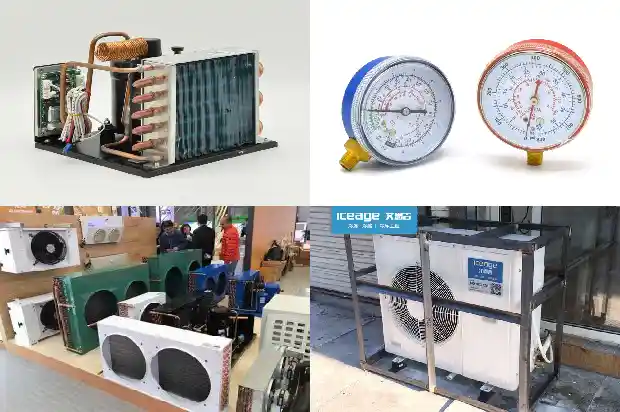How to Solve Practical Problems of Air - conditioner Leakage, Noise and Refrigerant Leakage?
2025-03-16
How to Solve Air - conditioner Problems?
When an air - conditioner has problems such as water leakage, electric leakage, poor cooling or heating performance, and excessive noise during use, it can be really frustrating for users. Buying an air - conditioner only to encounter these issues is quite a headache. However, there are certain precautions and common - sense knowledge that should be noted when using an air - conditioner. Let's take a look.
When an air - conditioner has problems such as water leakage, electric leakage, poor cooling or heating performance, and excessive noise during use, it can be really frustrating for users. Buying an air - conditioner only to encounter these issues is quite a headache. However, there are certain precautions and common - sense knowledge that should be noted when using an air - conditioner. Let's take a look.
Air - conditioner Water Leakage
- During the cooling operation of the air - conditioner in summer, with high air humidity, when the indoor unit's heat exchanger exchanges heat through the fan, due to its very low temperature, condensed water will be generated.
If there is water dripping or leakage under the indoor unit, check whether the pipes or the drainage pipe in the indoor part of the room have a certain slope, whether the drainage is smooth, or whether the outlet of the drainage pipe is inserted into water, which may affect normal drainage.
- When the air - deflector blows air downwards, the inner side of the air - deflector will become extremely cold. A large temperature difference will be formed between the inner and outer sides, which will absorb water vapor from the warm air, resulting in condensation on the air - deflector and then water dripping downwards.

It is recommended to adjust the air - deflector of the indoor unit to blow air at a horizontal angle.
What are the Culprits of Air - conditioner Noise?
- Installation of the air - conditioner indoor unit: After the outdoor unit starts running, take the copper pipe as an example. The copper pipe connects the indoor unit. If the indoor unit is not installed firmly enough, it will be affected by the compressor, resulting in resonance of the indoor unit.
- The main source of noise - the air - conditioner air outlet: The higher the wind speed when the air - conditioner is turned on, the gradually larger the noise value of the air - conditioner will be. This is one of the main sources of the air - conditioner's noise value.

- Compressor operation: The outdoor compressor of the air - conditioner is also one of the sources of air - conditioner noise. If the noise value of the compressor is too high, it will affect the normal use and rest of users.
- Loosening of the air - conditioner panel: After long - term use of the air - conditioner, the panel of the air - conditioner is likely to become loose for various reasons. In this way, the vibration generated when the air - conditioner is running will cause the panels to rub against each other, generating noise.
How to Quickly Detect Air - conditioner Refrigerant Leakage?
- "Touch by hand": Touch the condenser louvers at the back of the air - conditioner with your hand. If the temperature doesn't feel cool or there is no heat, and the compressor is still working, it indicates that the refrigerant has leaked.
- "Observe with eyes": In the cooling mode, adjust the temperature controller so that the set temperature is 6℃ - 8℃ lower than the room temperature. After running for 15 minutes, check the hydraulic pipe of the indoor unit (the thinner copper pipe). There should be no frost - formation. Otherwise, the unit has a refrigerant - leakage problem. Check whether there are oil marks at the copper - pipe joints. If there are, it also indicates a refrigerant - leakage phenomenon.
- "Listen with ears": If you find that the compressor has been running since startup without the vibration of stopping, and the self - vibration sound of the compressor is louder than when it was newly purchased, it may be an abnormal sound caused by refrigerant leakage.
- "Measure the temperature": Find a thermometer and place it near the cold - air outlet. Check whether the temperature indication on the thermometer is 6℃ - 8℃ lower than the room temperature. If it is lower than this temperature or less than 5℃, or even almost the same as the room temperature, and the compressor is still working, it proves that the refrigerant has completely leaked.
Related Articles
- Several Common Problems in the Operation of the Refrigeration System
- HVAC - Solving the 5 Common Problems in the Refrigeration System
- Five Common Problems in the Refrigeration System~~ Solve Them One by One!
- Have You Encountered the Three Common Problems of Refrigeration Compressors?
- How to Improve the Energy Efficiency of Air - conditioner Compressors?
- Maintenance Methods for Exhaust Volume and Winding Performance of Typical Air - conditioner Compressors
- Air Conditioners Also Have a "Shelf Life". If on a Tight Budget, Don't Rush to Replace. Try This and It Could Last a Few More Years
- Manifestations of Insufficient Air - conditioner Refrigerant and Judgment of the Charging Amount
- Do You Know All the 34 Components of the Air-cooled Multi-connected Unit?
- The "Horsepower" Rating, Power and Refrigeration Capacity of Air Conditioners
- Training on Precision Air Conditioners: Here's the Valuable Article You Need~~
- The horsepower of an air conditioner originally refers to the input power, including that of the compressor
- The Indoor Humidity Is Too High in Summer. How to Dehumidify? Can the Dehumidification Mode of the Air Conditioner Really Save Electricity and Money?
- Frosting in the Cold Storage? A Detailed Explanation of the 9 Reasons for Frosting of Air Coolers and 4 Defrosting Methods~~
- Why Does the Air Cooler Frost? What Are the Defrosting Methods?
- Noise Reduction and Vibration Damping in Refrigeration and Air Conditioning Systems
- Air-cooled, Water-cooled, Chilled Water, Dual Cooling Source and Free Cooling Precision Air Conditioners
- Installation and Welding of Precision Air Conditioning Systems
